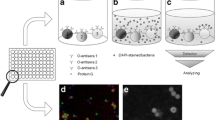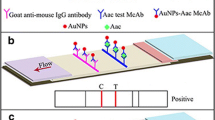Abstract
Two commercially available fluorescein isothiocyanate (FITC) -conjugated anti-Escherichia coli antibodies, tested for immunofluorescence were assessed for their suitability in screening E. coli using flow cytometry. Staining efficacy was initially tested using immunofluorescent microscopy; and further optimization was carried out using flow cytometry. Initially, an acetone fixation step was utilized; however, it was determined statistically that the step could be omitted without impacting the assay and thus reduce the time involved. There was no statistical difference between the staining proficiency of the two antibodies employed. The percentage staining was quite low, approximately 10% for the two antibodies, which indicated that both were equally sensitive but ultimately, more specific antibodies are required for the detection of E. coli. Known proportions of target-E. coli (105, 106, and 107 cells/ml) were mixed with large quantities of non-target bacteria; there was a significant correlation among all the antibodies at the different bacterial cell concentrations. Therefore, despite the low staining percentage achieved on the bacterial cultures, there is a representative and comparative level of staining occurring, between samples and between bacterial strains.


Similar content being viewed by others
References
DeCory TR, Durst RA, Zimmerman SJ, Garringer LA, Paluca G, DeCory HH, Montagna RA (2005) Development of an immunomagnetic immunoliposome-bead fluorescence assay for rapid detection of Escherichia coli O157:H7 in aqueous samples and the comparison of the assay with standard microbiological method. Appl Environ Microbiol 71:1856–1864
Deere D, Porter J, Edwards C, Pickup R (1995) Evaluation of the suitability of bis-(1,3-dibutylbarbituric acid) trimetine oxonol, (diBA-C4(3)-), for the flow cytometric assessment of bacterial viability. FEMS Microbiol Lett 130:165–170
E.P.A. (2005) Summary of approved and accepted microbiological methods for EPA water monitoring regulations. http://www.epa.gov/safewater/methods/rules_micro.html
E.P.A. (2005) Method 1103.1: Escherichia coli (E. coli) in water by membrane filtration using membrane-thermotolerant Escherichia coli Agar (mTEC). http://www.epa.gov/waterscience/methods/biosolids/EPA.Method.1103.1.E.coli.mTEC.Sep2005.pdf
E.P.A. (2005) Method 1681: fecal coliforms in sewage sludge (biosolids) by multiple-tube fermentation using A-1 medium. http://www.epa.gov/ost/methods/biosolids/EPA.Method.1681.Sep2005.pdf
Gerdts G, Luedke G (2006) FISH and chips: Marine bacterial communities analyzed by flow cytometry based microfluidics. J Microbiol Methods 64:232–240
Jepras RI, Carter J, Pearson SC, Paul FE, Wilkinson J (1995) Development of a robust cytometric assay for determining numbers of viable bacteria. Appl Environ Microbiol 61:2696–2701
Joux F, Lebaron P (2000) Use of fluorescent probes to assess physiological functions of bacteria at single-cell level. Microb Infect 2:1523–1535
Koch AL (1993) Biomass growth rate during the prokaryote cell cycle. Crit Rev Microbiol 19:17–42
LaGier MJ, Scholin CA, Fell JW, Wang J, Goodwing K (2005) An electrochemical RNA hybridization assay for detection of the fecal indicator bacterium Escherichia coli. Mar Pollut Bull 50:1251–1261
Lisle JT, Hamilton MA, Willse AR, McFeters GA (2004) Comparison of fluorescence microscopy and solid phase cytometry methods for counting bacteria in water. Appl Environ Microbiol 70:5343–5348
Lopez-Amoros R, Caster S, Comas-Riu J, Vives-Rego J (1997) Assessment of E. coli and Salmonella viability and starvation by confocal microscopy and flow cytometry using Rhodamine 123, DiBac4 (3), Propidium iodide and CTC. Cytometry 29:298–305
Makinoshima H, Aizawa S-I, Hayashi H, Miki T, Nishimura A, Ishihama A (2003) Growth phase-coupled alterations in cell structure and function of Escherichia coli. J Bacteriol 185:1338–1345
Marie D, Vaulot D, Partensky F (1996) Application of the novel nucleic acid dyes YOYO-1, YO-PRO-1 and Picogreen for flow cytometric analysis of marine prokaryotes. Appl Environ Microbiol 62:1649–1655
McCarthy M (2008) Optimization of immunological techniques for the detection of Escherichia coli in suspension and their application in the development of miniaturized flow cytometry system. MSc Thesis, Department of Zoology, Ecology & Plant Science, University College Cork, Cork, Republic of Ireland (unpublished)
Porter J, Edwards C, Morgan JAW, Pickup RW (1993) Rapid, automated separation of specific bacteria from lake water and sewage by flow cytometry and cell sorting. Appl Environ Microbiol 59:3327–3333
Porter J, Deere D, Pickup R, Edwards C (1996) Fluorescent probes and flow cytometry: new insights into environmental bacteriology. Cytometry 23:91–96
Rompré A, Servais P, Baudart J, de-Roubin M, Laurent P (2002) Detection and enumeration of coliforms in drinking water: current methods and emerging approaches. J Microbiol Methods 49:31–54
Roszak DB, Colwell RR (1987) Survival strategies of bacteria in the natural environment. Microbiol Rev 51:365–379
Roth BL, Poot M, Yue ST, Millard PJ (1997) Bacterial viability and antibiotic susceptibility testing with SYTOX green nucleic acid stain. Appl Environ Microbiol 63:2421–2431
Song JM, Vo-Dinh T (2004) Miniature biochip system for detection of Escherichia coli O157:H7 based on antibody-immobilized capillary reactors and enzyme-linked immunosorbent assay. Anal Chim Acta 507:115–121
Tanaka Y, Yamaguchi N, Nasu M (2000) Viability of Escherichia coli O157:H7 in natural river water determined by the use of flow cytometry. J Appl Microbiol 88:228–236
Tortorello ML, Stewart DS, Raybourne RB (1997) Quantitative analysis and isolation of Escherichia coli O157:H7 in a food matrix using flow cytometry and cell sorting. FEMS Immunol Med Microbiol 19:267–274
Veal DA, Deere D, Ferrari B, Piper J, Attfield PV (2000) Fluorescence staining and flow cytometry for monitoring microbial cells. J Immunol Methods 243:191–210
Acknowledgments
We would like to acknowledge the Marine Institute Advanced Technologies (Strategic Marine RTDI) Programme and the EPA as part of the Science, Technology, Research and Innovation for the Environment (STRIVE) Programme 2007–2013. The Irish Government under the National Development Plan 2007–2013 financed the research. The authors owe their thanks and appreciation to Maurice O’Donoghue, Department of Microbiology, University College Cork for his overall assistance in the laboratory.
Author information
Authors and Affiliations
Corresponding author
Rights and permissions
About this article
Cite this article
McCarthy, M., Culloty, S.C. Optimization of Two Immunofluorescent Antibodies for the Detection of Escherichia coli Using Immunofluorescent Microscopy and Flow Cytometry. Curr Microbiol 62, 402–408 (2011). https://doi.org/10.1007/s00284-010-9721-3
Received:
Accepted:
Published:
Issue Date:
DOI: https://doi.org/10.1007/s00284-010-9721-3




